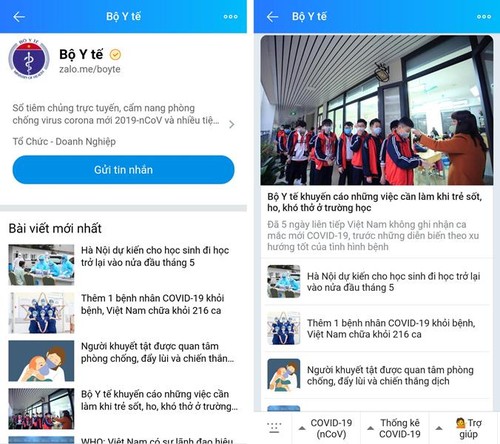 The Ministry of Health's official Zalo account makes regular updates on epidemic developments across Vietnam. The Ministry of Health's official Zalo account makes regular updates on epidemic developments across Vietnam.
|
Holding a smart phone, Pham Cong Tung of Trang commune, Gia Lai province, opens his Tan Lap hamlet's Zalo chat group to find COVID-19 news.
Every day, Tung says, the commune's Steering Committee for COVID-19 Prevention and Control sends two bulletins updating the epidemic situation in Gia Lai and other affected provinces and cities. Much of the information is presented in a graphic form, making it easier to figure out whether or not local people returning from another region need to complete a health declaration form.
Tung says that, through the group, the Committee can oversee whether people follow epidemic rules.
“The Zalo chat group is efficient, especially in regard to monitoring people arriving from another region or returning home from a quarantine facility. People with family members returning from another region can report their medical status to the local medical station through messaging or on a public website,” said Tung.
Tan Lap hamlet’s experience shows that social networks like Facebook and Zalo can help with epidemic communications in places with a widely scattered population.
With their wide coverage and fast dissemination of information, social networking platforms give people additional sources of COVID-19 information to help them respond to the pandemic.
En, Chairman of the People's Committee and head of the Steering Committee for COVID-19 Prevention and Control in Trang commune, says all five local hamlets have Zalo chat groups. Each group has 120 to 150 members representing all the local households.
According to En, committee members have joined the chat groups to quickly clear up people's questions about things like health declarations or quarantining at home.
“Thanks to the Zalo chat groups, the local authorities and Steering Committee can get information about returnees and make sure they are properly quarantined. Group members also know what they should do if they come back from an affected locality. For example, people returning from HCMC understand that they must go directly to the local medical station to complete a health declaration and then enter quarantine,” said En.
Online communications have reduced operating costs and increased the effectiveness of epidemic prevention measures, says Nguyen Thi Lan Anh of Lao Cai province’s Center for Disease Control.
She said, “I think providing feedback and posting information quickly and accurately on a fanpage or chat group are a great way to support the epidemic fight and help trace the origin of an outbreak."
Captain Dam Mai Minh Tuan of the police force of Dak Doa district in Gia Lai province, said, “If young people using social networks outnumber their elders, it’s easier to spread information. It only takes a few seconds to post new information on a social network for everyone to see.”
Major Khuat Duc Hieu, head of the Trang commune police, says that the Zalo chat groups enabled his unit to achieve their target of issuing 3,600 ID cards between March and June while still enforcing all COVID-19 prevention and control regulations.
“When they apply for an ID, we invite them to join our Zalo chat group. They then spread the word and encourage their neighbors to follow suit. A Zalo chat group creates a friendly environment and makes large gatherings unnecessary,” said Hieu.
Computers and smart phones are in wide use across Vietnam, even in remote areas. Statistics show that 73% of the population in Vietnam use at least one social network, with Facebook, Zalo, and movie-watching apps the most popular.